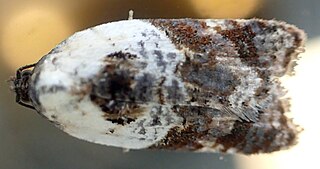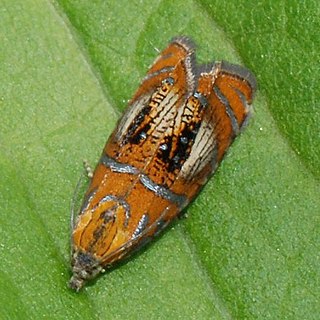
Acleris variegana, the garden rose tortricid moth or fruit tortricid, is a moth of the family Tortricidae. It has a Palearctic distribution. The moth flies from July to September mainly at night and is attracted to bright lights. The larvae feed on various trees and shrubs including rose and apple.

Enarmonia formosana, the cherrybark tortrix or cherry-bark moth, is a small but colorful moth species of the family Tortricidae. It is native to all of northern and western Europe, ranging south to the Maghreb. North of the Alps its range extends eastwards to Siberia and Kazakhstan. Possibly and most likely introduced populations are found in Asia Minor and North America, respectively.

Olethreutes arcuella, the arched marble, is a colorful small moth species of the family Tortricidae.

Celypha rufana, the lakes marble, is a small moth species of the family Tortricidae, long known under the junior synonym C. rosaceana.

Celypha striana is a moth of the family Tortricidae. It is the type species of its genus Celypha.

Cerastis rubricosa, the red chestnut, is a moth of the family Noctuidae. The species was first described by Michael Denis and Ignaz Schiffermüller in 1775. It is found in most of Europe, east through the temperate regions of the Palearctic east to Japan. In the north it is found just north of the Arctic Circle. Southward it is found up to the Mediterranean Basin and Turkey.

Celypha aurofasciana is a small moth species of the family Tortricidae. It is native to Europe and the Palearctic but occurs in some other places as an introduced species.

Argyroploce is a genus of moths belonging to the subfamily Olethreutinae of the family Tortricidae.

Celypha is a genus of tortrix moths. It belongs to the tribe Olethreutini of subfamily Olethreutinae.

Grapholita is a large genus of tortrix moths. It belongs to subfamily Olethreutinae, and therein to the tribe Grapholitini, of which it is the type genus.

Olethreutes is a large genus of tortrix moths. It is the type genus of its tribe (Olethreutini) and subfamily (Olethreutinae).

Orthotaenia is a genus of moths belonging to the subfamily Olethreutinae of the family Tortricidae.

The tortrix moth, genus Pammene, belongs to the tribe Grapholitini of the subfamily Olethreutinae.

Syricoris is a genus of moths belonging to the subfamily Olethreutinae of the family Tortricidae.

Philedone is a genus of moths belonging to the subfamily Tortricinae of the family Tortricidae. It contains only one species, Philedone gerningana, the cinquefoil tortrix or cinquefoil twist, which is found in Asia and Europe. It was first described by the Austrian lepidopterists Michael Denis and Ignaz Schiffermüller in 1775.

Cydia duplicana is a small moth of the family Tortricidae. It is found in all across Europe, extending barely into Asia in the Transcaucasus, Turkestan and Kazakhstan.

The Olethreutini are a tribe of tortrix moths.



















